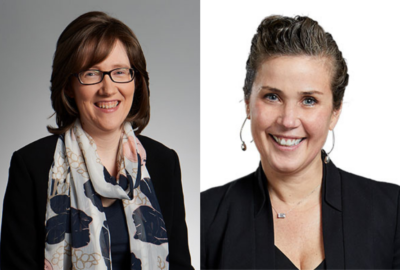
The head of federal at IBM has a multi-sided view of federal digital transformation
IBM federal has been many things over the years. Lately, it's been headed by a man with a unique perspective, an Army career officer, then chief information off...
Best listening experience is on Chrome, Firefox or Safari. Subscribe to Federal Drive’s daily audio interviews on Apple Podcasts or PodcastOne.
IBM federal has been many things over the years. Lately, it’s been headed by a man with a unique perspective, an Army career officer, then chief information officer of the Navy and of the Defense Department. Terry Halvorsen has seen IT investment and digital transformation from several angles. Federal Drive with Tom Temin caught up with him at the Sea Air Space conference this week.
Interview transcript:
Terry Halvorsen: So IBM in the last year has really simplified. So we have really two major divisions now, a technology and a consulting division. I lead the federal technology division, and there is my counterpart in consulting. And within that, we’ve really divided it into two teams, kind of a defense and intelligence team. And a civilian agency team, Ray Spicer leads the Defense Intelligence Team, and Lauren Craig runs our civilian side. And then underneath that, we’ve got, you know, basically 23 accounts that we divide the federal government into, and we are focused on technology and solutions. And I like to say we’re focused on solutions. And while there’s a difference between the solutions, and say, pure technology, and pure consulting, we are really trying to work together with the consulting team, too, but that’s been a big change. All of the brands at IBM, all of the technology developers are working now together on the technology side.
Tom Temin: And technology and solutions is primarily software solutions?
Terry Halvorsen: It’s software, it can be also be hardware, but primarily we are software focused.
Tom Temin: Does IBM still make hardware anymore?
Terry Halvorsen: We do, we do, as a matter of fact, we’re about to release. In this, we’ll probably get to one of our other topics. When you talk about hybrid environments today, and you’re talking about the federal government or I think any big enterprise, you’re still going to see lots of mainframe modern mainframes. And that is going to be part of a hybrid environment. So yes, we still make the best mainframes in the business.
Tom Temin: And do you think IBM federal will eventually climb into the top tier of cloud commercial services providers?
Terry Halvorsen: I’m going to say differently, we’re going to climb into the top tier of what I’m gonna say, is hybrid environments, and in a top tier of providing and orchestrating the new data fabric.
Tom Temin: Alright, and can you elaborate a little bit more on that?
Terry Halvorsen: Yeah. So today is what we just talked about, you’re going to have data that’s going to be best suited to stay in a mainframe-like environment. And it’s not the same mainframes we grew up with, this is modern. It’s much more secure, you’re also going to have cloud and then you’re going to have compute at the edge, which is one of the fastest growing positions. And we’re going to be in all of those places, we’re going to work with a lot of partners on that. But the biggest issue I see with the data fabric is going to be not so much being the individual provider of cloud, or data center, or at the edge, how do you orchestrate all of that? Because what really everybody wants is, you want to be able to get to that data, you need to make decisions faster. It’s about getting a speeded up decision cycle. That’s for warfare, business, you know, government, whatever, how do you orchestrate that in today’s environment, where you will truly, in that hybrid environment is going to require a new security architecture, to. You really are going to have to look beyond just putting up the walls around, you’re going to have to have better analysis all the time. And you’re going to have to replace some of the skills people are doing today with automation and analytics across that whole environment. That’s what we want to be the leader in.
Tom Temin: And that brings me to the next question with respect to semi-autonomous, uncrewed drone. That whole world is really dependent on that fabric to operate.
Terry Halvorsen: That is correct.
Tom Temin: And you’re doing a lot of work in that area.
Terry Halvorsen: We are. For us, and you mentioned some of the key areas, you know, timely today, if you’re following the headlines, you see that Ukraine, using drones, very, very effectively in their operations. U.S. government, lots of phases of it, DOD certainly gets into news for drones, but frankly, other parts of the government use drones. Everything from looking at pipelines, to looking at crops, and the data that they can gather and then actually synthesize on the platform is amazing. So that’s going to be an incredible growth business, all of that analytics. And you know, you take cybersecurity, people when you ask them, what’s the biggest problem with cybersecurity, you don’t have enough cybersecurity professionals. One of the ways to solve that problem is to have some of the analytics done by automated or AI engines.
Tom Temin: Is that what people mean by digital transformation?
Terry Halvorsen: It’s a big part of digital transformation. And and I think the other thing people have to look at about digital transformation is, what am I changing? And what do I need to change? I mean, I do think sometimes, industry and government leaders, we get a little confused, we have to change everything. Probably not a good solution. Some places data centers that are up there today, perfectly fine. They’re working, you know, what do you need to change in your fabric? What do you need to change in your architecture and architecture has kind of gotten maybe some negative feeling about it. You got to understand your architecture and you’ve got to understand your data requirements. I think that’s the other two areas we want to help people with is their architecture and understanding their data requirements.
Tom Temin: It all comes around to the data though somehow.
Terry Halvorsen: Everything is data today. And you can see all the quotes today. I mean, the chairman “data is the new ammunition”. You know, in business, you know, data is the new way to make money. It’s the it’s the advantage maker. So yes, data is the key today,
Tom Temin: We’re speaking with Terry Halvorsen, IBM federal general manager, former Defense Department and Navy CIO. And we should point out you had a naval career…
Terry Halvorsen: Army career.
Tom Temin: Army career, well, it’s Sea Air Space, my mind is, pulled toward the seas.
Terry Halvorsen: Correct. And we did a lot with the Navy.
Tom Temen: So and having been in all those environments, SES-level civilian and career military, and now corporate, commercial executive. What’s the most bureaucratic situation?
Terry Halvorsen: Yes. Here’s my theory. And you know, just gets me in trouble. I think after you get over 2000 people, I don’t care where you’re at. Government, industry, your bureaucracy is going to come in. I mean, it almost has to, because you’ve got to manage all those things that go along with that many people. So I don’t find the, government takes a big rap. It’s really, really bureaucratic. Some places it is, some places industry is, you know, the cop-out answer, but I have to say it does come down to the leaders, or leading. Size is going to be more bureaucratic and then how your leaders cope with that. The good leaders can cope with that size, they can cope with that scale. Other leaders deal with that less effectively.
Tom Temin: And any reference projects you want to talk about with respect to digital autonomy, AI, or is there anything in the U.S. or maybe even in a foreign military? There’s a lot of those walking by today, too.
Terry Halvorsen: Yeah, I mean, I think one of the things you and I talked about a little ahead of time, and I think we will talk – to replace the Mayflower. Which we’re doing, which is an autonomous vehicle, it’s, you know, it’s a vessel, which is coming across the Atlantic autonomously. You think about all the advantages of that. And that could apply to almost any type of vehicle. I mean, I think today, if you said, Where is the say, the U.S. government really using autonomous vehicles, and they’ve been doing it for a long time, and they’re getting better and better, more advanced is in explosive ordnance disposal. A great place not to send people. And those have become much, much better. I think a couple other projects that I’m seeing in Europe today is how do you improve the sensor grid for agriculture? I mean, two little known facts. But if you can control kind of soil hydration levels, and soil temperature, you can get sometimes 10 to 15% growth in your overall product press. And well, today, we have the sensors to do that. And we have fabric that can control temperature. So those projects are becoming more and more successful. And then as we talked earlier, I think the other big growth area that we see in the, particularly the federal government, defense agencies are using is how do you apply more analytics to cybersecurity? For two reasons; one to replace the people. Well, we’re not, I won’t say replace. Augment the people that you have, because, we’re short. But the other area is to make decisions on your network that humans can’t make at quick enough speed. So you have, you know, the AI engine that can be set up to take certain actions, when certain events are triggered, that can really prevent the spread of malware.
Tom Temin: Sounds like if you take away the ordinance aspect, so many of the commercial technologies and military requirements are really not that different anymore.
Terry Halvorsen: I think the basic requirement is the same. You have nuances in all of these areas, law enforcement, military, but yeah, you’re right. I think what we’re seeing that it is heartening to me, it’s something I talked about both as the DoN and the DoD CIO, we in government have got to take much more advantage of the commercial technology. It’s changing. They’re actually spending more in research. So to be successful, you really do have to reach into and take the best out of commercial technology.
Tom Temin: Terry Halvorsen is former Defense Department CIO, now general manager of IBM federal. I spoke with him at the Sea Air Space conference earlier this week at National Harbor.
Copyright © 2024 Federal News Network. All rights reserved. This website is not intended for users located within the European Economic Area.
Tom Temin is host of the Federal Drive and has been providing insight on federal technology and management issues for more than 30 years.
Follow @tteminWFED
Related Stories





